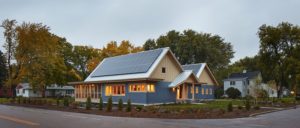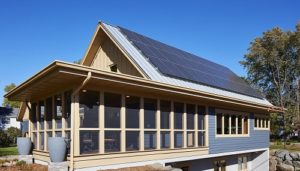There are net-zero energy homes, and then there are homes that go even further. The following project made sure it went a step beyond.

The homeowners wanted to build a home in the Minneapolis area that produced as much energy as both the house and their cars used over the span of a year. They hired Marc Sloot of SALA Architects and Kerry Hage of Hage Homes to lead the design and construction Design team. For best value and to ensure production from the solar panels could at least match consumption, they sought ways to reduce consumption as much as possible first. Thick insulation, passive solar tempering with triple pane windows, geothermal heat pumps, a high efficiency fresh air exchanger and ENERGY STAR-rated lights and appliances were all employed in the process.
This house was about more than just energy, though. The homeowners also gave preference to companies/manufacturers that used recycled content in their products, used renewable energy for their manufacturing and/or transportation and produced products without using toxic or harmful components such as volatile organic compounds (VOCs).

They also took a sustainable approach to their water usage. Interestingly, their motivation was not due to supply concerns. Instead, they wanted to reduce their total energy footprint, which included the energy devoted to water. Indoors, this meant utilizing low-flow fixtures in the showers and bathroom sinks. On the exterior, drought-tolerant turfgrass, in addition to xeriscape techniques, will greatly minimize the outdoor water demands. This property also contains 4 rain gardens that will be fed by either onsite rainfall or stormwater runoff from the street channeled onto the property via curb cuts. Finally, the project has four, fifty-gallon rain barrels. 200 gallons might not seem like a lot of capacity, but the landscaping is designed to require no more than average rainfall, and Minneapolis receives approximately 2.5 feet of rain per year.

“One of the reasons this project has scored Platinum in LEED v4 is the dedication to water reduction. While LEED for Homes pulls from the EPA WaterSense tool for outdoors and uses the LEED water performance spreadsheet for indoors, there is no uniform, agreed-upon tool to track or predict stormwater, rain water, black water or greywater use,” commented Brett Little, Executive Director for the Green Home Institute. “We were excited to use the WERS tool as a way to measure more accurately the rain barrel catchment for this project, which could be used to populate the rain/grey water section in the LEED Water Performance Pathway. Moreover, the WERS could theoretically be used to meet all of the water performance items asked for in LEED through 1 tool, rather than relying on 2 or 3 different tools which always allows for more error. We recommend contacting the USGBC to voice your opinion if you want to see WERS adopted as a substitute.”
“The great thing about building a comprehensive tool like WERS is that people can use it for a variety of purposes,” said Mike Collignon, Chair of the WERS Development Group. “We believe this precedent shows WERS can lend assistance to LEED projects and, hopefully, will open the door to its expanded usage within the LEED process.”
You can see this fascinating project by registering for the Green Home Institute’s Facebook Live tour, which is going on now. The coverage for this project is scheduled to air on Monday, July 24, 2017 at 12:00pm CT.
